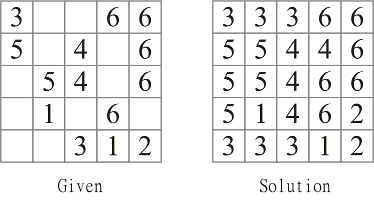4882 characters - Java
Not a very golfed solution (ie 4800 characters is a lotttttttttttt)
Could be golfed a bit more in that 1 or 2 debug printlines are still in there. I think I can reduce a fair bit still in terms of useless/optimized code.
import java.util.*;import java.awt.Point;public class G{public static void main(String[]args){new G();}Scanner z=new Scanner(System.in);public G(){s=z.nextInt();z.nextLine();int g[][]=new int[s][s];for(int i=0;i<s;i++)Arrays.fill(g[i],-1);for(int i=0;i<s;i++){String line=z.nextLine();for(int j=0;j<s;j++)if(line.charAt(j)!='.')g[i][j]=Integer.parseInt(Character.toString(line.charAt(j)));}System.out.println();if(y(g)){for(int i=0;i<s;i++)for(int j=0;j<s;j++)System.out.print(g[i][j]);System.out.println();}else System.out.println(0);}private boolean x(Collection<Point>c,int[][]d){if(c.size()==0)return true;int j=0;for(Iterator<Point>k=c.iterator();k.hasNext();k.next(),j++){for(int sol=9;sol>=0;sol--){int[][]a=new int[s][s];for(int i=0;i<s;i++)a[i]=Arrays.copyOf(d[i],s);List<Point>b=new ArrayList<Point>();for(Point p:c)if(!b.contains(p))b.add(new Point(p));a[b.get(j).x][b.get(j).y]=sol;if(w(a,b.get(j))){if(x(b,a)){for(int i=0;i<s;i++)d[i]=Arrays.copyOf(a[i],s);c.clear();c.addAll(b);return true;}}}}return false;}int s;private boolean y(int[][]d){int[][] a=new int[s][s];for (int i = 0; i<s;i++)a[i]=Arrays.copyOf(d[i],s);List<Point> incomplete=new ArrayList<Point>();if(r(a)&&s(a)){a(a);System.exit(0);}else if(!r(a)){q("INVALID FROM MAIN, ",12);return false;}for(int i=0;i<s;i++)for(int j=0;j<s;j++){if(a[i][j]!=-1)if(t(new Point(i,j),a,null,a[i][j]).size()!=a[i][j]){if(w(a,new Point(i,j))){a(a);if(y(a)){for(int i=0;i<s;i++)d[i]=Arrays.copyOf(a[i],s);return true;}else return false;}else return false;}}for(int i=0;i<s;i++)for(int j=0;j<s;j++)if(a[i][j]==-1){Set<Point>c=t(new Point(i,j),a,null,-1);if(x(c,a)){if(y(a)){for(int i=0;i<s;i++)d[i] = Arrays.copyOf(a[i], s);return true;}else return false;}else return false;}q("How did you get here",1);return false;}private boolean w(int[][]d,Point b){List<Point>c;Set<Point>a;a=t(b,d,null,d[b.x][b.y]);c=new ArrayList<Point>(u(b,d,null,d[b.x][b.y]));int h=d[b.x][b.y];int g=h-a.size();if(c.size()<g){return false;}else if(v(c,h,h,new ArrayList<Point>(a),0,d))return true;else return false;}private boolean v(List<Point>c,int h,int g,List<Point>e,int f,int[][]d){if(e==null)e=new ArrayList<Point>();int[][]a=new int[s][s];for(int i=0;i<s;i++)for(int k=0;k<s;k++)a[i][k]=d[i][k];if(f<g&&e.size()<g){for(int i=0;i<c.size();i++){if(!e.contains(c.get(i))){if(d[c.get(i).x][c.get(i).y]==h){for(Point c:e){a[c.x][c.y]=h;}Set<Point> u=t(e.get(0),a,null,h);Set<Point>v=t(c.get(i),a,null,h);if(!Collections.disjoint(u,v)){u.addAll(v);List<Point>uList=new ArrayList<Point>(u);if(v(c,h,g,uList,f+1,a)){q("this e sucess",2);if(y(d)){e.addAll(uList);return true;}}else;}for(int l=0;l<s;l++)for(int k=0;k<s;k++)a[l][k]=d[l][k];}else if(e.add(c.get(i))){if(v(c,h,g,e,f+1,d)){q("this e sucess",2);if(y(d))return true;}}if(e.contains(c.get(i)))e.remove(c.get(i));}}return false;}else if(f>g||e.size()>g){if(f>g){q("Your over the g. ");return false;}else return false;}else{for(Point c:e){a[c.x][c.y]=h;}if(r(a)){if(y(a)){for(int i=0;i<s;i++)d[i]=Arrays.copyOf(a[i],s);q("complete(a) is true, ",4);return true;}else{return false;}}else{return false;}}}private void q(String out,int i){System.err.println(out+". exit code: "+i);System.exit(i);}private void q(String a){q(a,0);}private boolean r(int[][] d){for(int i=0;i<s;i++)for(int j=0;j<s;j++)if(d[i][j]!=-1){Set<Point>same=t(new Point(i,j),d,null,d[i][j]);if(same.size()>d[i][j]){return false;}Set<Point>fae=u(new Point(i,j),d,null,d[i][j]);if(u(new Point(i,j),d,null,d[i][j]).size()<d[i][j]){return false;}}return true;}private Set<Point> u(Point p,int[][]d,Set<Point>u,int i){u=(u==null)?new HashSet<Point>():u;if(d[p.x][p.y]==i||d[p.x][p.y]==-1)u.add(p);int x=p.x,y=p.y;Point t=new Point();if(x+1<s&&(d[x+1][y]==i||d[x+1][y]==-1)){if(u.add(new Point(x+1,y)))u=u(new Point(x+1,y),d,u,i);}if(y+1<s&&(d[x][y+1]==i||d[x][y+1]==-1)){if(u.add(new Point(x,y+1)))u=u(new Point(x,y+1),d,u,i);}if(x-1>=0&&(d[x-1][y]==i||d[x-1][y]==-1)){if(u.add(new Point(x-1,y)))u=u(new Point(x-1,y),d,u,i);}if(y-1>=0&&(d[x][y-1]==i||d[x][y-1]==-1)){if(u.add(new Point(x,y-1)))u=u(new Point(x,y-1),d,u,i);}return u;}private Set<Point> t(Point p,int[][]d,Set<Point>u,int i){u=(u==null)?new HashSet<Point>():u;if(d[p.x][p.y]==i)u.add(p);int x=p.x,y=p.y;Point t=new Point(p);if(x+1<s&&d[x+1][y]==i){if(u.add(new Point(x+1,y)))u=t(new Point(x+1,y),d,u,i);}if(y+1<s&&d[x][y+1]==i){if(u.add(new Point(x,y+1)))u=t(new Point(x,y+1),d,u,i);}if(x-1>=0&&d[x-1][y]==i){if(u.add(new Point(x-1,y)))u=t(new Point(x-1,y),d,u,i);}if(y-1>=0&&d[x][y-1]==i){if(u.add(new Point(x,y-1)))u=t(new Point(x,y-1),d,u,i);}return u;}private boolean s(int[][]d){for(int i=0;i<s;i++)for(int j=0;j<s;j++)if(t(new Point(i,j),d,null,d[i][j]).size()!=d[i][j])return false;return true;}private void a(int[][]d){for(int i=0;i<s;i++){for(int j=0;j<s;j++){System.out.printf("%1s",d[i][j]==-1?".":Integer.toString(d[i][j]));}System.out.println("");}}}
Having never seen Polyominoes before this, I read up on what they are and without looking at solving alrogithms just made up my own (quite slow).
Basically, uses recursion a lot... Finds a Polyomino that's incomplete, tries to complete it.
Finds an empty space, Loops 1-9 through all squares in the pocket, sets that pocket to that value. If the pocket is complete, it tries to find another pocket, then repeats until finished. I couldn't get it to work for a grid of size 9... I have at least one optimisation in mind that could make it work within a reasonable time for 9. Might try to put that in place soon.

Is a recursive approach a valid answer if it works for a 9x9 board but will run out of memory for some larger size board? – trichoplax – 2015-07-04T23:36:19.273
1Yes.I don't expect you to be able to feasibly run a 31x31 or anything. Just so that you can actually run both the 5x5 and 9x9 above(to give output for the test cases), and would theoretically work for larger with the same algorithm (given a crap-ton of resources). – Geobits – 2015-07-05T02:22:52.960